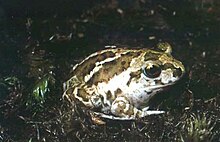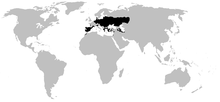European spadefoot toad
| European spadefoot toads Temporal range: Late Jurassic – Recent |
|
|---|---|
 |
|
| Pelobates fuscus fuscus | |
| Scientific classification | |
| Kingdom: | Animalia |
| Phylum: | Chordata |
| Class: | Amphibia |
| Order: | Anura |
| Suborder: | Mesobatrachia |
| Superfamily: | Pelobatoidea |
| Family: |
Pelobatidae Bonaparte, 1850 |
| Genus: |
Pelobates Wagler, 1830 |
| Species | |
|
Pelobates cultripes |
|
 |
|
| The distribution of extant pelobatids (in black). | |
Pelobates cultripes
Pelobates fuscus
Pelobates syriacus
Pelobates varaldii
The European spadefoot toads are a family of frogs, the Pelobatidae, with only one extant genus Pelobates, containing four species. They are native to Europe, the Mediterranean, northwestern Africa, and western Asia.
The European spadefoot toads are small- to large-sized frogs, up to 10 cm (3.9 in) in length, which are often inconspicuously coloured. They are predominantly fossorial (burrowing) frogs, which burrow in sandy soils. They have hardened protrusions on their feet to aid in digging, which is the source of the common name. They emerge from the ground during periods of rain and breed in pools, which are usually temporary.
All of the species from this family have free-living, aquatic tadpoles. The eggs are laid in temporary ponds that may quickly evaporate, so the tadpole stage is unusually brief, with rapid development to the adult form in as little as two weeks. To further speed their growth, some of the tadpoles are cannibalistic, eating their brood-mates to increase their supply of protein.
The seven species of American spadefoot toads (genera Scaphiopus and Spea) were previously also included into the Pelobatidae family, but are now generally regarded as the separate family Scaphiopodidae.
Family Pelobatidae
The earliest fossil genus of pelobatids, Elkobatrachus, was described in 2006.
In the Jurassic Morrison Formation, pelobatids are represented by the illium of an unnamed but indeterminate species. This illium is larger than that of Enneabatrachus, a contemporary discoglossid species. A specimen has been recovered from Quarry 9 of Como Bluff in Wyoming. Pelobatids are present in stratigraphic zones 5 and 6 of the formation.
...
Wikipedia
